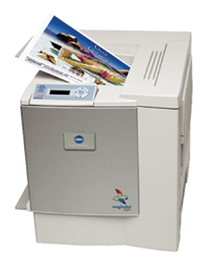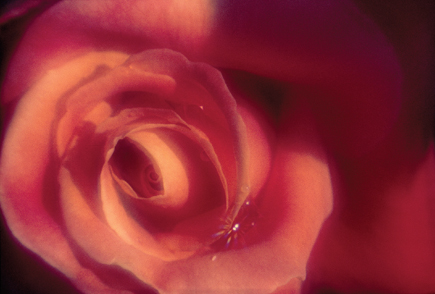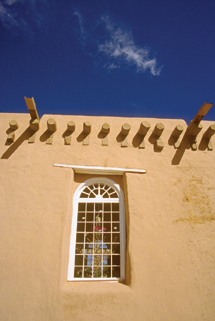A Different Printer Option For Photographers
Using The Konica Minolta magicolor 2350 EN Color Laser Printer
Photos © 2004, David B. Brooks, All Rights Reserved
From the earliest days of the digital darkroom it became progressively clear
that the color ink jet would become the dominant printer for photographers.
Dye sublimation printers still persist, but mostly as either snapshot or event
photographer printers. The one digital printer that is familiar to office workers,
but is seldom mentioned or considered by individual photographers, is the color
laser printer. However, now that good quality, name brand color laser printers
are much more affordable, I think it is time for their reconsideration.
 In
terms of reproducing photo-realistic prints, ink jets like the Epson Stylus
Photo R800 and the Canon i9900, which I recently tested, will remain the preferred
printer of most individual photographers. But all the same, ink jet printers
are not without shortcomings. Even though the initial cost is quite reasonable,
the cost of ink and paper to make the best quality prints with ink jets is substantial.
And in terms of speed an ink jet is a real turtle. The only rabbit-like performance
an ink jet is capable of printing is relatively low-resolution copies of text
documents, and even in that application it is still no "roadrunner."
This puts a photographer who needs to reproduce a high volume of prints, or
documents with photographs, at both a time and cost disadvantage. Enter the
color laser printer, which has a relatively low "ink" toner cost
and does its best quality printing on inexpensive, plain laser paper. In addition,
it will pound out duplicate copies in minutes, compared to the hours it might
take to do the same work with an ink jet.
In
terms of reproducing photo-realistic prints, ink jets like the Epson Stylus
Photo R800 and the Canon i9900, which I recently tested, will remain the preferred
printer of most individual photographers. But all the same, ink jet printers
are not without shortcomings. Even though the initial cost is quite reasonable,
the cost of ink and paper to make the best quality prints with ink jets is substantial.
And in terms of speed an ink jet is a real turtle. The only rabbit-like performance
an ink jet is capable of printing is relatively low-resolution copies of text
documents, and even in that application it is still no "roadrunner."
This puts a photographer who needs to reproduce a high volume of prints, or
documents with photographs, at both a time and cost disadvantage. Enter the
color laser printer, which has a relatively low "ink" toner cost
and does its best quality printing on inexpensive, plain laser paper. In addition,
it will pound out duplicate copies in minutes, compared to the hours it might
take to do the same work with an ink jet.
To test this assertion I decided to test a color laser printer to both establish
its output advantages as well as confirm its ability to reproduce photographic
images that would not "embarrass" a photographer. A few years back
while attending an industry trade show I observed a demonstration of the first
model of the Minolta 2300-series color laser printers. The good impression led
me to look up what Konica Minolta is currently offering, and I found one model
which was expressly touted for its ability to reproduce photographs, the Konica
Minolta magicolor 2350 EN, a letter-size color laser with a street price in
the $700-$800 range.
An Adventure Begins
The rather large, heavy box arrived with the magicolor 2350 EN printer and I
thought to myself, at least you get something more for its higher price. From
a less flippant perspective, the amount of "ink" toner supplied
with the printer is at least half the price that you might expect to pay with
an ink jet and should last most users for a long time and a lot of prints. And,
the size actually involves little if any more need for desk space than a typical
letter-size ink jet; however, the magicolor 2350 EN is just a lot taller. And
although the software utilizes an operating system PostScript driver that installs
a PPD specific to the printer, setting up and installing the Konica Minolta
color laser was nearly as easy as a contemporary ink jet. You also have two
of the same printer/computer connections, a USB and parallel for PCs, plus an
RJ-45 10/100BaseTX network connector if you want to use the magicolor 2350 EN
as a network printer. For an individual user like myself I found I had the printer
running and making prints in short order. Printing from applications is just
about the same as with any other desktop printer.
 |
|
|
Color laser printers require quite different paper media than ink jets, although
"plain" paper can be used with each. If you go to an office supply
store you will find popular paper brands that offer general-purpose papers for
either an ink jet or a laser printer. Unlike ink jets, though, there is not
a wide selection of specially coated papers like the resin-based ink jet papers
that mimic the look and feel of analog photo papers. That said, companies like
Hammermill do make high-quality "glossy" paper for color laser printers.
In addition, higher quality rag-content bond papers can also be used effectively
with a color laser printer. However, most usual stationery-type bond papers
have a watermark and are often not very opaque, so using them to print full-page
photo images is not really a suitable application. So, being used to a selection
of media types with ink jets, and few apparent corresponding laser printer options
in specific papers for laser printers, I did a little experiment. (However,
if you should be similarly inclined, be aware a laser printer involves heat
to adhere the "ink" toner to the paper, and the use of a resin-based
paper might melt the resin and could likely damage the printer!)
After trying some of the dedicated laser papers and some high-quality stationery
paper, I came to the conclusion that the better quality, but inexpensive, paper
made for color laser printers reproduces color photographs as well as any kind
of paper. The premium glossy papers made for color laser printers look really
slick and work well with documents that contain smaller photo images plus type
and maybe graphics. But if most of the page is made up of a photographic image
the result is not ideal, as the "ink" toner is duller than the gloss
of the paper. For a really glossy look it might be best to use a very thin laminated
gloss application, like used on the cover of some magazines. I also found high-quality
lightweight card stock, often used for printing invitations, works well for
full-page photographic images, especially when you want a heavier, richer look
and feel.
 |
|
|
Calibrating And Profiling The magicolor 2350 EN
Upon receiving the new PPD that allowed turning off the magicolor 2350 EN's
internal color controls, I made a set of prints of an ICC color test chart with
each of the papers I tested. (Anyone with a flat-bed scanner that supports making
raw scans, and color management software like ColorVision's ProfilerPLUS,
can easily calibrate and profile a color laser printer.) After reading the printed
charts, using ColorVision's SpectroPRO Suite, and making a profile for
each paper, I was set to do some serious printing of photographs using Photoshop.
With the magicolor 2350 EN's print driver set for no internal color control,
I used the Print With Preview window dialog in Photoshop (Versions 7.0, CS,
Elements 3.0) and went to the optional CMS section at the bottom and selected
my work space Adobe RGB (1998) as the Source Space profile. I used the paper
profile for the Print Space, then hit the Print button.
- Log in or register to post comments

































